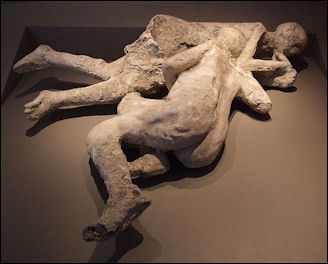VESUVIUS
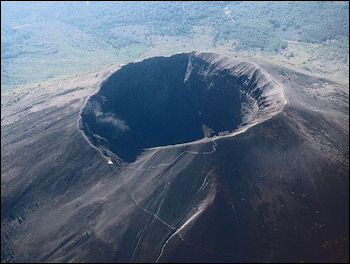
Vesuvius from a plane Vesuvius, one the world's most famous volcano, looms above the Bay of Naples. It exploded with huge force on August 24, A.D. 79 and buried the cities of Pompeii and Heracuelum and killed many of their residents.
Vesuvius (10 miles from Naples) is 4,203 feet (1,281 meters) high. It is now relatively quiet but still very active. The bottom of the crater is about 800 feet below the crater rim. Several fumaroles innocuously release fumes. Vesuvius actually lies inside the exploded remnants of an older volcano. A ridge from the much large volcano lies on the north edge.
The chamber where Vesuvius’s magma is stored is seven miles below the earth's surface. The collision between the African plate and the European plate in southern Italy produces molten rock, rich in volatile gases. Under pressure these gases stay dissolved. But when the magma rises to the surface, the gases expand and when they are released they tend to produce explosive eruptions.
Some scientists regard Vesuvius as the world's most dangerous volcano. An estimated 1 million people live within the "death zone" five miles of the crater and three million live within an eight-mile radius of the crater. Should the volcano repeat its Pompeii performance ashfall, pyroclastic flows, and mud slides would probably destroy 500,000 homes and kill 200,000 people if no warnings were given and no preparations were made. A huge pyroclastic flow like the one that occurred in 1780 B.C. could wipe out all of Naples.
A large eruption in 1631, when there was only a 24 hour warning that something was amiss, killed 4,000 people. Streams of lava were produced by frequent eruptions in the 18th, 19th and 20th centuries but few people were hurt. The last major eruption occurred during World War II in 1944, when there were small ash showers and a small lava flow. Clouds of ash blew towards U.S. bombers as they headed toward German targets. About 45 people were killed and 88 Allied aircraft based nearby were damaged. Some serious damage occurred in some places but the eruptions was nothing like the one in A.D. 79. Since 1944 the volcano has been mostly quiet. Some say this is bad news: a sign that pressure is building up inside and it could blow violently when next time it erupts.
The area around Vesuvius is the only real volcanically active region of the European mainland. Nearby on the island of Ischia is a volcano that erupted in 1302 and opposite the Bay of Naples from Vesuvius are the Phlegraean Fields which are made up of 20 craters, including one, Monte Nuovo, which was formed by an eruption in 1538. About 36,000 years ago an eruption occurred here that dwarfed both Krakatau and Mount St. Helens and covered the area with a layer of ash 160 feet thick. In the 1980s the region started to kick up again but all is quiet now.
See Separate Articles VOLCANO COMPONENTS, STRUCTURE AND ACTIVITY factsanddetails.com ;VOLCANIC ERUPTIONS: TYPES, PHASES AND CAUSES factsanddetails.com ; DESTRUCTIVE ERUPTIONS: LAHARS, PYROCLASTIC FLOWS AND GLACIAL BURSTS factsanddetails.com
Websites and Sources on Volcanoes: USGS Volcanoes volcanoes.usgs.gov ; Volcano World volcano.oregonstate.edu ; Volcanoes.com volcanoes.com ; Wikipedia Volcano article Wikipedia , Smithsonian Global Volcanism Program volcano.si.edu operated by the Smithsonian has descriptions of volcanoes around the globe and a catalog of over 8,000 eruptions in the last 10,000 years.; Websites on Ancient Rome: Internet Ancient History Sourcebook: Rome sourcebooks.fordham.edu ; Internet Ancient History Sourcebook: Late Antiquity sourcebooks.fordham.edu ; Forum Romanum forumromanum.org ; “Outlines of Roman History” forumromanum.org; “
Eruptions of Vesuvius
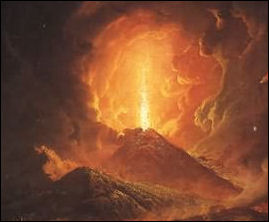
Vesuvius lets loose with a major eruption about once every 2000 years. The last one was the famous one that destroyed Pompeii in B.C. 79. The one before that was in 1780 B.C. Before that there were major ones about 8,000 years ago, 11,400 years ago, 15,000 years ago, 17,000 years ago, 22,500 years ago and 25,000 years ago.
Vesuvius is plugged by a huge cork of solid rock, which according to some estimates is 10 kilometers thick. It takes a huge amount of energy and pressure for the magma chamber below the rock to blow a hole to the surface. When Vesuvius erupts it typically releases a massive column of hot ash and stones, mostly light. air-hole-filled pumice and harder, more rock-like lapilli. Liquid rock is propelled into the air at supersonic speeds, producing a sonic boom. The cloud of material produced in A.D. 79 that Pliny the Younger wrote was shaped like an umbrella pine tree.
The way the eruption unfolds and the damage occurs depends on where the crater on the volcano is (which determines where the pyroclastic flows might go) and wind directions (which determines where the ash cloud will go). Eruption occurring in ancient Monte Somma crater have funneled pyroclastic flows in the direction of Naples. Wind in 1780 B.C. carried the fallout mainly to the east while winds in B.C. 97 carried debris from that eruption to the south towards Pompeii.
The height of the Vesuvius changes from eruption to eruption. It looks now like the top half of the mountain is missing, which is in partly true. The mountain was several hundred feet higher in A.D. 79. It is now 4,203 feet high, 140 feet or so shorter than it was during its last major eruption in 1906. Vesuvius's major eruptions occur at the end of a cycle that begins with a 7 year quiescent period which is followed by 20 to 30 years of minor activity before the mountain finally blows.
Pyroclastic Surges and Mudlfows from Vesuvius
During Vesuvius eruptions a column of ash, gas and heated rock collapses on itself, creating burning hot clouds in a pyroclastic surges that shoot out sideways and flow down the slopes initially at great speed, destroying everything in their path. Many volcanos have produced pryoclastic flows but the ones produced by Vesuvius cover many kilometers, making Vesuvius in the eyes of some experts perhaps the world’s most dangerous volcano.
Stephen Hall wrote in National Geographic, “A pyroclastic surge is baked in a subterranean chamber to temperatures of up to 1650 degrees F. The initial surge of the eruption, especially in the zones closest to Vesuvius is instantly lethal. Hot, choking, wind, advancing at about 240 miles an hour, reach temperatures of at least 900 degrees F, and retain enough heat to bring water to a boil ten miles from the event.”
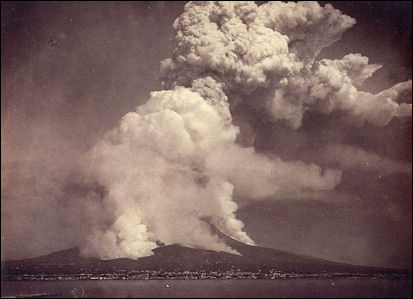
Vesuvius1872 Giuseppe Mastrolorenzo, a volcanologist at the Osservatorio Vesuviano in Naples, told National Geographic, “Below 200 degrees Fahrenheit, you can survive for several seconds, perhaps if the wave passes quickly...But even if you survive the temperature , you will suffocate on the fine powder in the air.”
“When vast amounts of solid ash and debris mixes with steam fed by underground aquifers,” Hall wrote, “a violent microclimate of pitched thunderstorms and torrential rains occurs, producing great mudflows. Ash falling into rivers creates more mudflows, known as lahars, that fill river valleys long after the eruption is over.” Mastrolornzo said, “There are more victims from the mudlfows than from the eruption itself. These mud flows travel with a force that moves houses hundreds of meters,”
Avellino Eruption of Vesuvius in 1780 B.C.
In 1780 B.C. Vesuvius exploded with more powerful blast than it did in A.D. 79. A pyroclastic surge and flow engulfed an area to the north of the volcano about 30 kilometers north to south and 30 kilometers east to east and destroyed almost everything in its path. This is a huge area, covering all of modern-day Naples and its suburbs and much of the countryside surrounding it too. [Source: Stephen Hall, National Geographic, September 2007]
Mastrolorenza and Peir Paolo Petrone, an anthropologist at the University of Naples, are two figures who have been at the forefront of trying to figure what happened during the 1780 B.C. eruption geologically and anthropologically. They have done this primarily by measuring ash depths in different places and studying footprints of victims as they fled the eruption. The eruption is sometimes called the Avellino eruption because volcanic material was found at the town of Avelliono about 40 kilometers to east.
Mastrolorenzo, Petrone and American volcanologist Michael Sheriden sparked interest in the eruption in the spring of 2006 with a paper about it in the Proceeding of the National Academy of Sciences (PNAS) in which they said the Avellion event “caused a social-demographic collapse and the abandonment of the entire area for centuries.”
The initial blast hurled material — cinders, heated rock and ash — at a rate of 100,000 tons a second. A column reached about 35 kilometers into the stratosphere — roughly three times the altitude of cruising commercial airliners. The column of ash may have hung in the air for as long as 12 hours. Pumice and lapilli collected into piles as high as three meters near the volcano. This eruption and what occurred afterwards also offers a scary warming what is store for the modern Naples metropolitan area, and its three million people, sometime in the not too distant future. If an Avellino eruption occurred without warning today everyone in Naples would die.
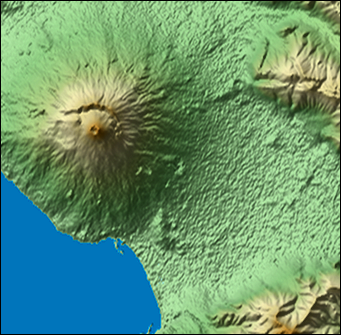
Vesuvius from a satellite Describing what the blast must have been like for villagers from 1780 B.C. whose bones were found in 1995, Stephen Hall wrote in National Geographic, “When the first thunderous boom echoed across the plain of Campania, quickly followed by a blistering hail of volcanic rock, the men and the woman had abandoned their village and made a run for it to the east.. A violent downpour of rubbly pumice mixed with incandescent rocks capable of crushing skulls and scalding skin obscure their escape....Thousands of other people were at the same moment running for their lives, marking the soft ash and wet volcanic mud with footprints...The people whose footprints led to the north or northwest chose a path that probably saved their lives; those who set out to the east...unwittingly chose a bath that led them to certain death. They headed by ill luck, smack into the middle of a fallout zone that would swiftly bury them under three feet of pumice.” Victims either died from trauma wounds caused by being struck on the head by large volcanic rocks of by being slowly asphyxiated.
Mastrolornzo told National Geographic, “The entire countryside surrounding Vesuvius was covered by foot upon foot of the powder produced by the pyrcoclastic flow: “645 feet deep at a distance of three miles from the crater and about 10 inches thick at a distance of 15 miles. Eight inches of ash is enough to cause modern roofs to collapse.”
Eruption of Vesuvius in A.D. 79
At about 1:00pm on August 24, A.D. 79 Vesuvius exploded like a nuclear weapon. After about a half an hour volcanic debris started to cover Pompeii. For 11 hours the volcano thrust a column of pumice, ash and fumes 20½ miles into the stratosphere at a rate of 1.5 million tons per second, turning day into night and releasing more thermal energy than 100,000 Hiroshima atomic bombs. Warning signs before the eruption included an earthquake a few weeks before and wells mysteriously going dry. There was no lava, the eruption was too violent for that.
As the column of ash and cinders cooled it began to spread horizontally and drift with the wind. As it cooled further solid particles began raining down. Pompeii and the ancient city of Stabiae were buried under the volcanic debris while Heracuelum succumbed to fiery avalanches of gas and volcanic debris. The event is sometimes called the pliny eruption because it was described by great Roman scholar Pliny the Elder, who died in the eruption, and his nephew Pliny the Younger, who was 30 kilometers away in Misenum.
There were 15 earthquakes before Mt. Vesuvius erupted and covered Pompeii. Joshua Hammer wrote in Smithsonian Magazine: “It was on the afternoon of August 24, A.D. 79, that people living around long-dormant Mount Vesuvius watched in awe as flames shot suddenly from the 4,000-foot volcano, followed by a huge black cloud. “It rose to a great height on a sort of trunk and then split off into branches, I imagine because it was thrust upwards by the first blast and then left unsupported as the pressure subsided,” wrote Pliny the Younger. “Sometimes it looked white, sometimes blotched and dirty, according to the amount of soil and ashes it carried with it.”[Source: Joshua Hammer, Smithsonian Magazine, July 2015 ~|~]
“Volcanologists estimate that the eruptive column was expelled from the cone with such force that it rose as high as 20 miles. Soon a rain of soft pumice, or lapilli, and ash began falling over the countryside. That evening, Pliny observed, “on Mount Vesuvius broad sheets of fire and leaping flames blazed at several points, their bright glare emphasized by the darkness of night.”Many people fled as soon as they saw the eruption. But the lapilli gathered deadly force, the weight collapsing roofs and crushing stragglers as they sought protection beneath staircases and under beds. Others choked to death on thickening ash and noxious clouds of sulfurous gas.In Herculaneum, a coastal resort town about one-third Pompeii’s size, located on the western flank of Vesuvius, those who elected to stay behind met a different fate. Shortly after midnight on August 25, the eruption column collapsed, and a turbulent, superheated flood of hot gases and molten rock—a pyroclastic surge—rolled down the slopes of Vesuvius, instantly killing everyone in its path.~|~
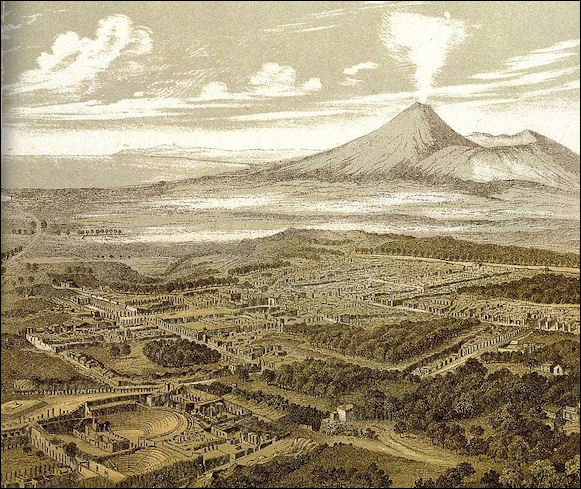
Vesuvius and Pompeii
“Pliny the Younger observed the suffocating ash that had engulfed Pompeii as it swept across the bay toward Misenum on the morning of August 25. “The cloud sank down to earth and covered the sea; it had already blotted out Capri and hidden the promontory of Misenum from sight. Then my mother implored, entreated and commanded me to escape as best I could....I refused to save myself without her and grasping her hand forced her to quicken her pace....I looked round; a dense black cloud was coming up behind us, spreading over the earth like a flood.” Mother and son joined a crowd of wailing, shrieking and shouting refugees who fled from the city. “At last the darkness thinned and dispersed into smoke or cloud; then there was genuine daylight....We returned to Misenum...and spent an anxious night alternating between hope and fear.” Mother and son both survived. But the area around Vesuvius was now a wasteland, and Herculaneum and Pompeii lay entombed beneath a congealing layer of volcanic material.... Doomed by proximity to Vesuvius, the two cities of Pompeii and Herculaneum were entombed within a day. Accounts at the time documented the spread of the ash cloud beyond Rome, as far as Egypt and Syria. ~|~
Effect of the Eruption of Vesuvius in A.D. 79 on Pompeii
Pompeii's fate of being downwind from Vesuvius on that day had more to do than anything else with it being buried by ash. Ash and pumice fell on Pompeii at a rate of six inches an hour. This in itself wasn't enough to kill anyone at first, but mixed in were bowling-ball-size volcanic bombs that were. After four hours roofs began to collapse from the weight of the ash and after 17 hours over 9 feet of ash had fallen.
An estimated 80 percent of Pompeii's resident probably survived by fleeing early. Those that stayed were probably able to survive the ashfall of the first day, if their roofs didn't collapse, by staying indoors and breathing through rags. But on second day, just as the ash was starting to let up and people began venturing outdoors, pyroclastic flows of superheated gas and ash surged through the city. These flows reached Pompeii on August 25. The first at 5:30am stopped just outside Pompeii's walls. The second one, an hour later, entered the city and probably asphyxiated most of its residents. The third and most devastating surge is the one that caused Pliny to flee Misenum. This one, which came three hours after the first, buried Pompeii and entombed its victims.
After that there were more pyroclastic surges as well as mud flows, but by that time everyone that was going to die was already dead, Hall wrote: “The pattern of its deposits, the swirl of its volcanic signature in layers thick and thin, has allowed volcanologists to conclude that Vesuvius unleashed at least six cycles of pyroclastic surge and flow in that single eruption’six bursts of searing winds followed by six rampaging rivers of mud — that destroyed everything within about nine miles of the volcano. The immediate cataclysm probably lasted less than 24 hours, but it turned an idyllic landscape into a monochromatic desert, uninhabitable for 300 years,”
Death at Pompeii from Eruption of Vesuvius

Garden of the FugitivesAbout 2,000 people died in Pompeii. Many it is believed initially fled but returned to collect their money and belongings. Not many died during the initial ash fall. Many died after being trapped in ash for hours. Most of the dead perhaps were killed in a 30 second thermal blast and pyroclastic surge. Many died pressing pillows ro their faces in a vain attempt to keep from inhaling gas. Many also died clinging to valued possessions or objects that might bring them good luck.
Describing a possible scenario for the death for four people on the second day of the eruption, Doug Stewart wrote in Smithsonian magazine, “under a lurid and sulfurous sky, a family of four struggles down an alley filled with pumice stones, desperately trying to escape the beleaguered city of Pompeii. Leading the way is a middle-aged man carrying gold jewelry, a sack of coins and the keys to his house. Racing to keep up are his two small daughters, the younger one with her hair in braids. Close behind their mother, scrambling frantically through the rubble with her skirts hiked up. She clutches an amber statuette of a curly-haired boy, perhaps Cupid, and the family silver, including a medallion of Fortuna, the goddess of luck.”
“But neither amulets nor deities can protect them. Like thousands of others this morning, the four are overtaken and killed by an incandescent cloud of scorching gases and ash from Mount Vesuvius. In the instant before he dies, the man strains to lift himself from the ground with one elbow. With his free hands, he pulls a corner of his cloak over his face, as though the thin cloth will save him.”
Plaster Casts of the Dead at Pompeii
The most memorable and shocking reminders of what happened at Pompeii are the plaster casts that have been made of the victims whose bodies left cavities in the hardened volcanic debris. The cavities — which served as molds for the plaster casts — were created when volcanic ash mixed with rainwater and hardened around the victims, whose bodies rotted away over the years. Grim images of the dead have been made by pouring plaster into cavities. The technique was first used in 1863 by Italian archaeologist Giuseppe Fiorelli who noticed four cavities in the hardened ash and filled them with plaster, revealing lifelike castes.

cast of a dog The cavities of around 2,000 people have been found in Pompeii. Among them are ones made by a pregnant women on her back, her husband covering her mouth with his own in a last kiss or mouth to mouth resuscitation. Casts have been made of a baby, curled up tightly, on its back, another baby sprawled on its back, a man climbing some stairs, a man crouching holding his face, and a woman hugging and protecting her baby. The cast of a child with upward-thrusting arms is so detailed you can see that his eyes were closed and his mouth was open. He was found with his parents and a younger sibling in the House of the Golden Bracelet, under a staircase, which collapsed and killed them. There are also casts of animals, including a chained dog.
Describing the deaths of what were probably slaves Stewart wrote in Smithsonian magazine, “During the night of the 24th, the worsening rain of ash and stones blocked doors and windows on the ground floor and poured through atrium skylights at the House of Meander, one of the city’s grandest homes. In the darkness a group of ten people with a single lantern...tried fanatically to climb from the pumice-filled entrance hall to the second floor. . In a nearby hall facing a courtyard, three more struggled to dig an escape route with a pick ax and a hoe. All died.” One reason they are thought to have been slaves is that were found with few possessions other than a couple coins and a few glass beads. Those that died with valuable object were reasoned to be wealthy citizens.
Effect of the Eruption of Vesuvius in A.D. 79 on Herculaneum
Most of the dead at Herculaneaum perished instantaneously when a pyroclastic flow surged through the city. The vast majority of Herculaneum’s roughly 5,000 inhabitants probably escaped before that happened as only a few dozen people have been found in the city itself.
Describing what happened to them, Doug Stewart wrote in Smithsonian magazine, “Shortly after noon on August 24, the sky over Herculaneum darkened ominously, The wind, however, pushed Vesuvius ash well to the southeast...Not long after midnight, a glowing cloud of superheated gas, ash and debris roared down the mountain’s western flank towards the sea....Large numbers of Herculaneum’s residents had fled towards the sea in hopes of escaping by boat.”
Geologist Phil Janney told Smithsonian magazine: “Pyroclastic surges move quite rapidly , between 50 and 100 miles per hour, You can’t outrun then. You don’t even get much warning.” A large number of people appeared to have been trapped in boats, where they were burned alive by a pyroclastic surge that was so hot it melted coins into solid blocks of bronze and silver.”
Death at Herculaneum from Eruption of Vesuvius

cast of a babyFew human remains had been found in Herculaneum. In the 1980s archaeologists discovered the remains of nearly 300 dead, including 150 bodies that were discovered in 1982 in a group of warehouses near the seafront, where they apparently had fled. Some of the skulls have clenched teeth, others have their mouths wide open, testimony that they died a sudden, painful death. The find was also valuable archaeologically. Since the Romans cremated their dead there are very few Roman skeletons.
One chamber contained the remains of 12 people huddled together, a few of them embracing each other. Cradled in the arms of one adult was an infant. The head of another was buried facedown, as if sobbing, into a pillow. In a nearby chamber are the tangled remains of 40 individuals, and one horse, that looked to be in panic and chaos when their final moments arrived. An in yet another chamber the bodies where organized into neat rows as if they were rowing a huge ghost ship.
The remains of a pregnant woman were found along with a tiny skeleton of her seventh-month fetus. Another woman later called the Ring Lady was found with two large jeweled rings and two exquisite gold bracelets shaped like serpents with heads at each end. A third woman, with buck teeth, was judged to be a prostitute by the structure of her pelvic bones. The analysis a 45 year old man showed him to be undernourished, overworked and in continual pain as a result of his rotting teeth and fused discs in his spine.
In 2001, Petrone and Mastrolorenzo published a paper in the journal Nature providing evidence that hundreds of fugitives who gathered in 12 seafront “fornci “, or boathouses, facing the beach of Herculaneum died instantly from a pyroclastic surge that reached temperatures of 932 degrees F, vaporizing clothing and flesh within seconds. The victims were huddled together in groups of 5,10 and 12. From the position of the bones the scientists determined they died instantly. Small black and blue marks left on skulls were caused when brain tissue boiled and exploded and splattered on the skulls. Moisture from vaporized flesh and blood combined to create a protective, plasterlike material that preserved bones. Much of Herculaneum still lies under 20 meters of hard rock and it is difficult to determine the exact number of dead there.
Pliny the Elder and the Eruption of Vesuvius
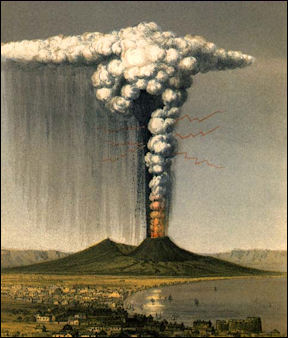
Vesuvius in 1822 While most people headed as quickly as they could away from Pompeii, the very curious Roman historian and naturalist Pliny the Elder headed straight for it. At the time of the eruption Pliny and his nephew, Pliny the Younger, were across the Bay of Naples, 15 miles from Vesuvius and 20 miles away from Pompeii. The elder Pliny considered the eruption a novelty and, taking a Roman fleet with him, sailed towards Pompeii. The nephew initially stayed behind and wrote an account of what happened, apparently pieced together from his own observations and the accounts of survivors.
Pliny the Younger wrote that Pliny the Elder "had been out in the sun, and taken a cold bath" and "my mother drew his attention to a cloud of unusual size and appearance...It was not clear from which mountain the cloud was rising. Later we knew it was Vesuvius...My uncle's scholarly acumen saw at once it was important enough for a closer inspection and he ordered a boat to be made ready."
"He was entirely fearless...he hurried to the place everyone else was hastily leaving...Ashes were already falling, hotter and thicker as the ships drew near." His boat was bombarded with fiery ashfall and blocked with floating rafts of pumice but eventually he made it to Stabiae which was about the same distance from Pompeii as Pompeii was from Vesuvius.
To calm his friends Pliny told them "the broad sheets of fire and leaping flames" were "nothing but the bonfires left by peasants." Later, while his companions debated whether to stay in their house or flee, Pliny slept soundly through the first night of the eruption. When the houses starting shaking violently, they put pillows on their heads to protect themselves from falling rocks.”
Pliny the Elder died in the eruption of Vesuvius. He advised calm when the volcano began erupting and stayed in Pompeii even though he had enough warning to escape. He went outside the day after the initial eruption, on August 25, with a pillow tied to his head. Some think that Pliny the Elder died choked by ash after landing in the beach near Pompeii.
Pliny the Younger wrote that August 25, was "blacker and denser than any ordinary night." Violent waves made escape by sea impossible. Pliny grew tired and repeatedly asked for cold water. Then suddenly the "flames and smell of sulphur" drove his companions to flight. The elder Pliny collapsed, perhaps from a heart attack or from breathing in toxic fumes, and two days later his body was found on a beach at Stabiae "entire an uninjured...its postured that of sleeping, rather than a dead man."
Pliny the Younger and the Eruption of Vesuvius
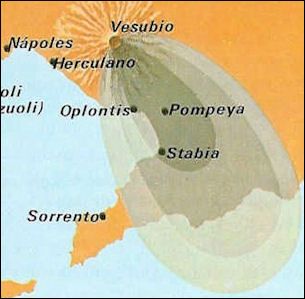
ash deposits from AD 79 eruption Meanwhile, Pliny the Younger, who was a safe enough distance away in Minsenum, was interrupted from his studies by a "fearful black cloud” that “was rent by forked and quivering bursts of flame." The cloud moved across the bay "and parted to reveal great tongues of fire like flashes of lightning magnified in size...We also saw the sea sucked away and apparently forced back by the earthquake.” He described the initial cloud as being of “unusual size and appearance.” He said it reminded him of an umbrella pine tree “for it rose to a great height on a sort of trunk and then split off into branches.”
Pliny the Younger fled along with most of the other terrified residents of Misenum. As the cloud descended," many besought the aid of the gods, but still more imagined there were no gods left, and that the universe was plunged into darkness for evermore."
"You could hear the shrieks of women and wailing of infants, and the shouting of men: some were calling for their parents, others their children and wives...There were people, too, who added to the real perils by inventing factious dangers: some reported that a part of Misenum had collapsed or another part was on fire."
"The flames remained a distance off; then darkness came on once more and the ashes began to fall again, this time in heavy showers. We rose from time to time and shook them off, otherwise we should have been buried and crushed beneath the weight.” When the cloud eventually lifted “everything changed, buried deep in ashes like snowdrifts."
Pliny the Younger’s Letter 6.16 on the Vesuvius Eruption
Pliny the Younger (A.D. 61- 113) recorded the events he witnessed from Misenum on the northern arm of the Bay of Naples, about 30 kilometers (19 miles) west of Vesuvius. He wrote to to Cornelius Tacitus in Letter 6.16:“Thank you for asking me to send you a description of my uncle's death so that you can leave an accurate account of it for posterity 1....“My uncle was stationed at Misenum, in active command of the fleet. 2 On 24 August, in the early afternoon, my mother drew his attention to a cloud of unusual size and appearance. He had been out in the sun, had taken a cold bath, and lunched while lying down, and was then working at his books. He called for his shoes and climbed up to a place which would give him the best view of the phenomenon. It was not clear at that distance from which mountain the cloud was rising (it was afterwards known to be Vesuvius); its general appearance can be best expressed as being like an umbrella pine 3, for it rose to a great height on a sort of trunk and then split off into branches, I imagine because it was thrust upwards by the first blast and then left unsupported as the pressure subsided, or else it was borne down by its own weight so that it spread out and gradually dispersed.
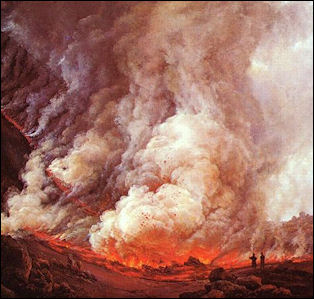
Sometimes it looked white, sometimes blotched and dirty, according to the amount of soil and ashes it carried with it. My uncle's scholarly acumen 4 saw at once that it was important enough for a closer inspection, and he ordered a boat to be made ready, telling me I could come with him if I wished. I replied that I preferred to go on with my studies, and as it happened he had himself given me some writing to do. [1. Tacitus' description of the eruption of Vesuvius and the death of Pliny the Elder would have been in the part of his Histories that does not survive; remember his narrative breaks off in 70 CE, some years before the volcanic disaster. 2. Pliny the Elder was praefectus classi, praefect of the fleet, appointed by the emperor and holding imperium. 3. A particular kind of pine tree known in the Mediterranean, shaped in outline like an umbrella (hence the name); we would call this a "mushroom cloud". 4. As the author of the encyclopedic Natural History, Pliny would naturally have been interested in this unusual phenomenon] [Source: Pliny the Younger (A.D. 61- 113). Letters 6.16 and 6.20, From Penguin translation by Betty Radice]
“As he was leaving the house, he was handed a message from Rectina, wife of Tascius whose house was at the foot of the mountain, so that escape was impossible except by boat. She was terrified by the danger threatening her and implored him to rescue her from her fate. He changed his plans, and what he had begun in a spirit of inquiry he completed as a hero. He gave orders for the warships 5 to be launched and went on board himself with the intention of bringing help to many more people besides Rectina, for this lovely stretch of coast was thickly populated. He hurried to the place which everyone else was hastily leaving, steering his course straight for the danger zone. He was entirely fearless, describing each new movement and phase of the portent to be noted down exactly as he observed them. Ashes were already falling, hotter and thicker as the ships drew near, followed by bits of pumice and blackened stones, charred and cracked by the flames: then suddenly they were in shallow water, and the shore was blocked by the debris from the mountain. For a moment my uncle wondered whether to turn back, but when the helmsman advised this he refused, telling him that Fortune stood by the courageous 6 and they must make for Pomponianus at Stabiae. He was cut off there by the breadth of the bay (for the shore gradually curves round a basin filled by the sea) so that he was not as yet in danger, though it was clear that this would come nearer as it spread. Pomponianus had therefore already put his belongings on board ship, intending to escape if the contrary wind fell.
This wind was of course full in my uncle's favour, and he was able to bring his ship in. 7 He embraced his terrified friend, cheered and encouraged him, and thinking he could calm his fears by showing his own composure, gave orders that he was to be carried to the bathroom. After his bath he lay down and dined 8; he was quite cheerful, or at any rate he pretended he was, which was no less courageous. [5. Pliny originally was going to head toward Vesuvius in a small light galley; after receiving the note, he ordered out the larger quadriremes, as they were much larger and better able to take numbers of people to safety. 6. Variations on this idiomatic saying, "Fortune favors the brave," can be found in a number of Roman authors. 7. So at first, apparently, wind is blowing toward the mountain, allowing Pliny's sails to push the boats toward the shore, but making it difficult to launch sailboats in flight from Pompeii and/or Herculaneum. The wind would later shift, according to the debris pattern preserved archaeologically. 8. Romans reclined on couches to dine formally.]
“Meanwhile on Mount Vesuvius broad sheets of fire and leaping flames blazed at several points, their bright glare emphasized by the darkness of night. My uncle tried to allay the fears of his companions by repeatedly declaring that these were nothing but bonfires left by the peasants in their terror, or else empty houses on fire in the districts they had abandoned. Then he went to rest and certainly slept, for as he was a stout man his breathing was rather loud and heavy and could be heard by people coming and going outside his door. By this time the courtyard giving access to his room was full of ashes mixed with pumice-stones, so that its level had risen, and if he had stayed in the room any longer he would never have got out. He was wakened, came out and joined Pomponianus and the rest of the household who had sat up all night. They debated whether to stay indoors or take their chance in the open, for the buildings were now shaking with violent shocks, and seemed to be swaying to and fro, as if they were torn from their foundations. Outside on the other hand, there was the danger of falling pumice-stones, even though these were light and porous; however, after comparing the risks they chose the latter. In my uncle's case one reason outweighed the other, but for the others it was a choice of fears. As a protection against falling objects they put pillows on their heads tied down with cloths.
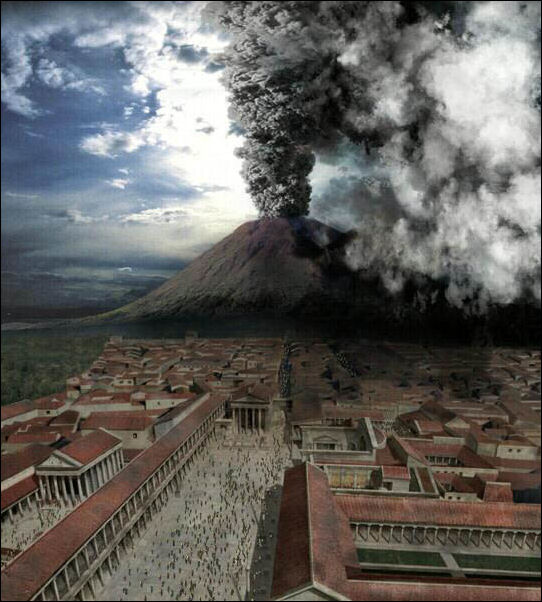
from the Discovery Channel TV show Last Day of Pompeii
“Elsewhere there was daylight by this time, but they were still in darkness, blacker and denser than any ordinary night, which they relieved by lighting torches and various kinds of lamp. My uncle decided to go down to the shore and investigate on the spot the possibility of any escape by sea, but he found the waves still wild and dangerous. A sheet was spread on the ground for him to lie down, and he repeatedly asked for cold water to drink. Then the flames and smell of sulphur which gave warning of the approaching fire drove the others to take flight and roused him to stand up. He stood leaning on two slaves and then suddenly collapsed, I imagine because the dense fumes choked his breathing by blocking his windpipe which was constitutionally weak and narrow and often inflamed. When daylight returned on the 26th—two days after the last day he had seen—his body was found intact and uninjured, still fully clothed and looking more like sleep than death.”
Pliny the Younger’s Letter 6.20 on the Vesuvius Eruption
Pliny the Younger (A.D. 61- 113) wrote to to Cornelius Tacitus in Letter 6.20: “So the letter which you asked me to write on my uncle's death has made you eager to hear about the terrors and hazards I had to face when left at Misenum, for I broke off at the beginning of this part of my story. "Though my mind shrinks from remembering…I will begin. After my uncle's departure I spent the rest of the day with my books, as this was my reason for staying behind. Then I took a bath, dined, and then dozed fitfully for a while. For several days past there had been earth tremors which were not particularly alarming because they are frequent in Campania: but that night the shocks were so violent that everything felt as if it were not only shaken but overturned. My mother hurried into my room and found me already getting up to wake her if she were still asleep. [Source: Pliny the Younger (A.D. 61- 113). Letters 6.16 and 6.20, From Penguin translation by Betty Radice]
“By now it was dawn, but the light was still dim and faint. The buildings round us were already tottering, and the open space we were in was too small for us not to be in real and imminent danger if the house collapsed. This finally decided us to leave the town. We were followed by a panic-stricken mob of people wanting to act on someone else’s decision in preference to their own (a point in which fear looks like prudence), who hurried us on our way by pressing hard behind in a dense crowd. Once beyond the buildings we stopped, and there we had some extraordinary experiences which thoroughly alarmed us. The carriages we had ordered to be brought out began to run in different directions though the ground was quite level, and would not remain stationary even when wedged with stones. We also saw the sea sucked away and apparently forced back by the earthquake: at any rate it receded from the shore so that quantities of sea creatures were left stranded on dry sand. On the landward side a fearful black cloud was rent by forked and quivering bursts of flame, and parted to reveal great tongues of fire, like flashes of lightning magnified in size.
“At this point my uncle’s friend from Spain spoke up still more urgently: "If your brother, if your uncle is still alive, he will want you both to be saved; if he is dead, he would want you to survive him—why put off your escape?" We replied that we would not think of considering our own safety as long as we were uncertain of his. Without waiting any longer, our friend rushed off and hurried out of danger as fast as he could.
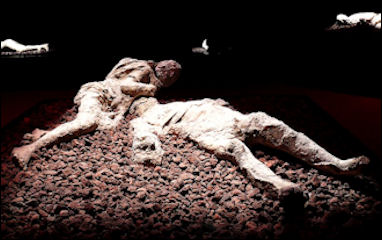
“Soon afterwards the cloud sank down to earth and covered the sea; it had already blotted out Capri and hidden the promontory of Misenum from sight. Then my mother implored, entreated and commanded me to escape the best I could—a young man might escape, whereas she was old and slow and could die in peace as long as she had not been the cause of my death too. I refused to save myself without her, and grasping her hand forced her to quicken her pace. She gave in reluctantly, blaming herself for delaying me. Ashes were already falling, not as yet very thickly. I looked round: a dense black cloud was coming up behind us, spreading over the earth like a flood. "Let us leave the road while we can still see," I said, "or we shall be knocked down and trampled underfoot in the dark by the crowd behind." We had scarcely sat down to rest when darkness fell, not the dark of a moonless or cloudy night, but as if the lamp had been put out in a closed room. You could hear the shrieks of women, the wailing of infants, and the shouting of men; some were calling their parents, others their children or their wives, trying to recognize them by their voices. People bewailed their own fate or that of their relatives, and there were some who prayed for death in their terror of dying. Many besought the aid of the gods, but still more imagined there were no gods left, and that the universe was plunged into eternal darkness for evermore. There were people, too, who added to the real perils by inventing fictitious dangers: some reported that part of Misenum had collapsed or another part was on fire, and though their tales were false they found others to believe them. A gleam of light returned, but we took this to be a warning of the approaching flames rather than daylight. However, the flames remained some distance off; then darkness came on once more and ashes began to fall again, this time in heavy showers. We rose from time to time and shook them off, otherwise we should have been buried and crushed beneath their weight. I could boast that not a groan or cry of fear escaped me in these perils, had I not derived some poor consolation in my mortal lot from the belief that the whole world was dying with me and I with it.
“At last the darkness thinned and dispersed into smoke or cloud; then there was genuine daylight, and the sun actually shone out, but yellowish as it is during an eclipse. We were terrified to see everything changed, buried deep in ashes like snowdrifts. We returned to Misenum where we attended to our physical needs as best we could, and then spent an anxious night alternating between hope and fear. Fear predominated, for the earthquakes went on, and several hysterical individuals made their own and other people’s calamities seem ludicrous in comparison with their frightful predictions. But even then, in spite of the dangers we had been through, and were still expecting, my mother and I had still no intention of leaving until we had news of my uncle.”
Archaeological Areas of Pompeii, Herculaneum and Torre Annunziata
According to UNESCO: “When Vesuvius erupted on 24 August A.D. 79, it engulfed the two flourishing Roman towns of Pompei and Herculaneum, as well as the many wealthy villas in the area. These have been progressively excavated and made accessible to the public since the mid-18th century. The vast expanse of the commercial town of Pompei contrasts with the smaller but better-preserved remains of the holiday resort of Herculaneum, while the superb wall paintings of the Villa Oplontis at Torre Annunziata give a vivid impression of the opulent lifestyle enjoyed by the wealthier citizens of the Early Roman Empire. [Source: UNESCO World Heritage Site website =]
James W. Jackson wrote in the Villa of Mysteries at Pompeii website: “In the first century the Roman Empire contains many cities, but none in a more beautiful setting than the cities and towns lining the Bay of Naples. On the 24th of August, 79 A.D., volcanic ash spews from Mt. Vesuvius. Pompeii and nearby Herculaneum disappear from the face of the earth. Gradually grass and vines cover the land where the towns stood. The local people eventually forget even the name of the buried towns. [Source: James W. Jackson, Villa of Mysteries at Pompeii website]
“Herculaneum was rediscovered in 1738 and Pompeii in 1748. By the mid-eighteenth century, when scholars made the journey to Naples and reported on the findings, the imagination of Europe was ignited. Suddenly, the classical world was in vogue. Philosophy, art, architecture, literature, and even fashion drew upon the discoveries of Pompeii and Herculaneum for inspiration; the Neoclassical movement was under way.
Joshua Hammer wrote in Smithsonian Magazine:“Since 1748, when a team of Royal Engineers dispatched by the King of Naples began the first systematic excavation of the ruins, archaeologists, scholars and ordinary tourists have crowded Pompeii’s cobblestone streets for glimpses of quotidian Roman life cut off in medias res, when the eruption of Mount Vesuvius suffocated and crushed thousands of unlucky souls. From the amphitheater where gladiators engaged in lethal combat, to the brothel decorated with frescoes of couples in erotic poses, Pompeii offers unparalleled glimpses of a distant time. “Many disasters have befallen the world, but few have brought posterity so much joy,” Goethe wrote after touring Pompeii in the 1780s.” [Source: Joshua Hammer, Smithsonian Magazine, July 2015 ~|~]
Image Sources: Wikimedia Commons, The Louvre, The British Museum
Text Sources: Internet Ancient History Sourcebook: Rome sourcebooks.fordham.edu ; Internet Ancient History Sourcebook: Late Antiquity sourcebooks.fordham.edu ; Forum Romanum forumromanum.org ; “Outlines of Roman History” by William C. Morey, Ph.D., D.C.L. New York, American Book Company (1901), forumromanum.org \~\; “The Private Life of the Romans” by Harold Whetstone Johnston, Revised by Mary Johnston, Scott, Foresman and Company (1903, 1932) forumromanum.org |+|; BBC Ancient Rome bbc.co.uk/history/ ; Perseus Project - Tufts University; perseus.tufts.edu ; MIT, Online Library of Liberty, oll.libertyfund.org ; Gutenberg.org gutenberg.org Metropolitan Museum of Art, National Geographic, Smithsonian magazine, New York Times, Washington Post, Los Angeles Times, Live Science, Discover magazine, Times of London, Natural History magazine, Archaeology magazine, The New Yorker, Encyclopædia Britannica, "The Discoverers" [∞] and "The Creators" [μ]" by Daniel Boorstin. "Greek and Roman Life" by Ian Jenkins from the British Museum.Time, Newsweek, Wikipedia, Reuters, Associated Press, The Guardian, AFP, Lonely Planet Guides, “World Religions “ edited by Geoffrey Parrinder (Facts on File Publications, New York); “History of Warfare “ by John Keegan (Vintage Books); “History of Art “ by H.W. Janson Prentice Hall, Englewood Cliffs, N.J.), Compton’s Encyclopedia and various books and other publications.
Last updated October 2018

